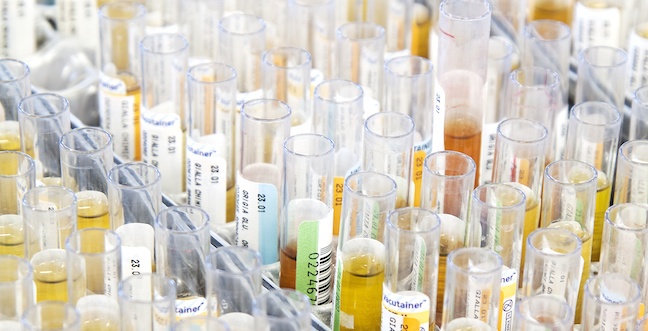By Agnieszka Sitarska
Liquid chromatography-tandem mass spectrometry (LC-MSMS) adds a lot of analytical power when you need to quantify small molecules in body fluids, but a simple approach of ‘dilute and shoot’ is not going to be enough to ensure robust analysis. Sample prep methods can well be the single biggest time consumer you are facing, which means that a wise choice of sample prep method is a great opportunity for improving lab productivity.

Efficient sample preparation can improve productivity and results in LC-MSMS.
Choosing a sample prep method for LC-MSMS may seem bewildering, with complex and contradictory recommendations from applications chemists and the scientific literature. But a basic understanding of the principles of sample preparation combined with a structured approach to selecting, optimizing and validating a sample preparation protocol can pay off, with great savings in time and major improvements in assay quality. Let’s start by looking at why sample prep is so important.
The need for sample prep in small molecule LC-MSMS
Body fluids need to be refined before running them on LC-MSMS for three reasons:
1. Preventing clogging: Proteins and other sample components can become particulate when injected into the LC mobile phase stream, so they need to be depleted or diluted to prevent damage to the LC column and overpressure in the LC system.
2. Improving chromatographic separation: The volume and composition of the sample injected into the LC system has a profound effect on chromatography and can modify peak shapes, peak separation and retention times and therefore affect the quantitation limits, selectivity and robustness of the assay. So the complex mixture of proteins, carbohydrates, lipids, and salts in body fluids must be simplified before injecting the sample.
3. Increasing reliability: The precision and accuracy of the method and long-term stability of the LC-MSMS instrument response is almost always improved by selectively depleting the biological matrix.
Matrix depletion is a vital step so let’s look into this in more detail.
Why matrix depletion?
The first reason is to improve assay quality and meet regulatory guidelines. To be detected by MSMS, compounds must be ionized by atmospheric pressure ionization (API) in the LC-MSMS ion source, which converts uncharged analytes in the liquid phase to ions in the gas phase. Achieving and maintaining assay quality means avoiding interference in the ionization of analytes by components of the residual biological matrix that co-elute. This matrix effect differs between samples and between analytes, causing errors in quantitation.
One very effective way of compensating for the matrix effect is to include a co-eluting stable-isotope labeled internal standard, but modern LC-MSMS demands more than just adding an internal standard and proceeding with validation. Consensus guidelines and accreditation requirements for validation now include detailed criteria for evaluating the matrix effect (see references 1-4). For example, the CAP checklist states that the average matrix effect determined in at least ten different sources of matrix during method validation must be <25% and the CV for matrix effect must be <15%. If not, ”validation studies must include data to demonstrate that matrix effects do not affect assay accuracy.” So a sample preparation protocol that effectively depletes matrix becomes crucial if regulatory demands are to be met.
The second reason for depleting matrix is simply a question of achieving the cleanliness needed to maximize uptime of the MSMS instrument. Cleaner samples mean longer MSMS maintenance-free intervals and more hours of productive instrument time. Every injection of a biological sample deposits some residual matrix on the MSMS hardware and gradually degrades ion handling. Over time, you may see progressively lower responses caused by fewer ions reaching the MSMS detector until eventually the instrument fails system suitability testing and must be cleaned. This can mean a lot of downtime since each cycle of venting, cleaning, and pump down again to achieve high vacuum status can take up to 24 hours.
How to select a LC-MSMS sample prep method
Efficient sample prep is critical to analytical success and productivity in LC-MSMS. The next article in this series will give you some guidance on how to select a sample preparation method, with general tips for protocol development.
Stay Updated
Want to know more about the latest methods in mass spectrometry? Subscribe to our blog to receive updates.
Acknowledgements
Tecan would like to thank Judith Stone, Ph.D., MT(ASCP), DABCC for technical consultation about sample preparation for LC-MSMS. Judith Stone is the senior clinical laboratory scientist specialist at the University of San Diego toxicology laboratory in the Center for Advanced Laboratory Medicine.
References
- European Medicines Agency Guideline on bioanalytical method validation, 2012. https://www.ema.europa.eu/documents/scientific-guideline/guideline-bioanalytical-method-validation_en.pdf (accessed on 30 May, 2017).
- S. FDA Guidance for Industry, Bioanalytical Method Validation, 2001 & 2013.
- Scientific Working Group for Forensic Toxicology [SWGTOX] Standard Practices for Method Validation in Forensic Toxicology, 2013.
- College of American Pathologist’s [CAP] Chemistry and Toxicology Accreditation Checklist, 2016.
About the author

Agnieszka Sitarska
Agnieszka Sitarska is a junior product manager for consumables at Tecan Männedorf. She studied Biotechnology at Jagiellonian University in Krakow, Poland, and completed her Master’s thesis at Novartis Institute for Biomedical Research in Basel, Switzerland. After her studies, she worked in the pharmaceutical industry, gaining experience in business support, before joining Tecan in July 2016.











